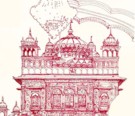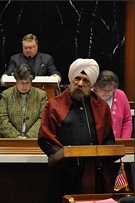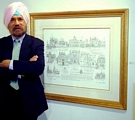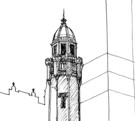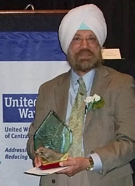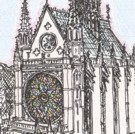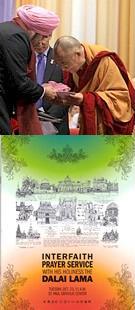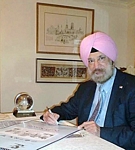Power of Architecture
by Annette Jones
The Daily Journal
Johnson County, Indiana
November 8-9, 2003
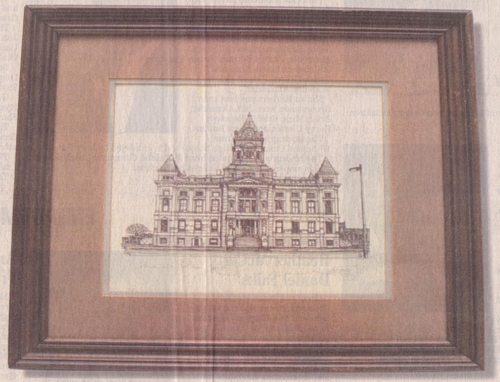
K.P. Singh’s distinctive pen-and-ink drawings of historic architecture and monuments in Indiana and abroad reflect the spirit that inspired the landmarks.
Singh’s drawings will be both familiar and foreign to Indiana residents. His art depicts the Johnson County Courthouse and Old Main at Franklin College and other structures in the United States, the Far East, Europe and India.
A collection of his work will be on display at the Indianapolis Art Center from Friday through Jan. 18. Singh will have more than 30 drawings on display and will sign his book, “The Art and Spirit of K.P. Singh” on opening night.
The exhibit, In Search of the Spirit, is part of the Spirit and Place festival that runs through Nov. 19 in Indianapolis.
Kanwal Prakash Singh thinks human genius is reflected in architecture.
“Architecture is not only space, brick, mortar and stained glass,” he says. “I think of architecture as a living entity. I think of it as a building that has a spirit and character, a sense of its own.
“I’m not standing under the great dome of Michelangelo in St. Peter’s Square in Rome and thinking, ‘This is a Catholic church, and I’m a Sikh.’ I’m thinking, ‘What grandeur, what vision, what beauty, what daring and what imagination,’ and so is everyone else.”
An architect, Singh came to the United States from India in 1965 as a student at the University of Michigan. He studied city planning, earning his second master’s degree and fourth college degree. In 1967, he moved to Indianapolis, where he joined the Department of Metropolitan Development.
He stepped down as senior planner after 4-1/2 years to start K.P. Singh Designs, specializing in architecture with a message. He began drawing historic homes, courthouses, college campuses, churches, synagogues and other historic structures.
In October, he released a book of drawings, “The Art and Spirit of K.P. Singh.”
The book contains drawings of 45 courthouses, including the Johnson County Courthouse, along with 200 other drawings and 11 photographs. More than 150 drawings are from Indiana.

Also included in the book are some of Singh’s thoughts, prayers, reflections, poems and essays on architecture, culture, matters of spirit and thoughts on historic preservation.
He describes American architecture as daring and simpler than the architecture of ancient and Middle Age European countries.
“We have gone beyond displaying our pioneering spirit and are setting new markers in innovation,” he says.
All over the country, buildings make a statement about power, strength and confidence, as the World Trade Center did, he says.
Architecture that looks simple, such as Clowes Memorial Hall in Indianapolis, as compared to an opera house in Paris, for example, is strong and functional with the acoustics it offers.
“We can embellish these structures if we want to, but it is the space that is created that creates an aura of our soul,” Singh says.
Yet he is an advocate for preserving the architecture of the past.
“I have looked at the heritage of an ancient country like India and wonder if we were constantly looking for something new, these buildings that are 1,500 years old would have never survived,” he says.
He says historic buildings should not be allowed to deteriorate or disappear, either by design or neglect. Singh says, whenever feasible, owners should take a second or third look at a deteriorating building to see if it can be preserved for another use, so years from now, people will say, “That’s the journey of our ancestors, that’s where they came from, that’s what they did, these are the things they cherished.”
Like Singh, Rob Shilts, executive director of the historic preservation group Franklin Heritage, says city planners should always first try to adapt existing buildings to preserve architecture.
When that isn’t possible, existing structures should be complemented, Shilts says.
“One of the key components to being sympathetic to existing architecture is to use some of the same types of materials as existing architecture, to borrow from the context around it,” he says. “I don’t mean to copy detail to detail, but at least pay homage to it by using similar materials: the same kind of window height and banding to make it blend in seamlessly.
“A number of architects have done that successfully,” he says.
But, of course, appreciation of architecture depends on a person’s taste.
“A lot of people had a fit about I.M. Pei’s pyramid that he added at the Louvre,” Singh says. “Yet I think, as time has elapsed, we have become very accustomed to this jewel that allows light from within to go out and light from outside to go in.”
